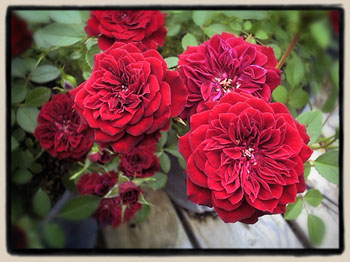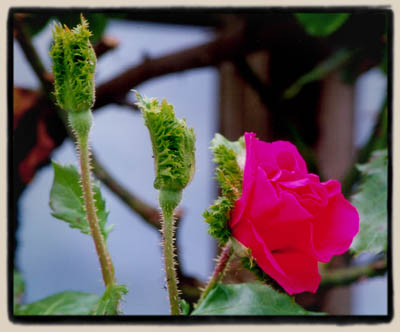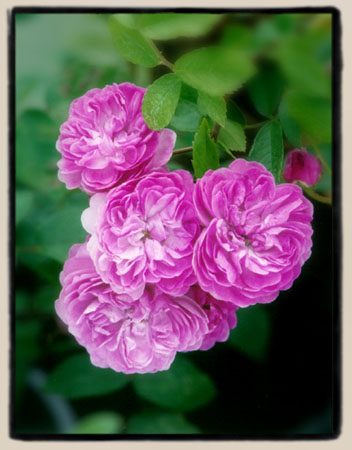|

What's
new
Albas
Bourbons
Centifolias
Chinas
Climbers
Damasks
English Roses
Gallicas
Hyb. Bracteatas
Hyb. Musks
Hyb. Perpetuals
Hybrid Teas
Miniatures
Modern Shrubs
Moss Roses
Noisettes
Rugosas
Species
Teas
Site
Index
Email
|
 Ralph
Moore has bred and introduced some of the most remarkable rose hybrids
of our century. When the first of his true miniatures began appearing
on the market decades ago, Hybrid Teas were the king of American gardens.
He took a big chance all those years ago by breeding the tiny roses
he loved so much, hoping that other people would find them as charming
as he did. Needless to say, America was very happy to adopt these little
garden gems for their own. I have heard it said that miniature roses
now outsell all other roses four to one! Ralph
Moore has bred and introduced some of the most remarkable rose hybrids
of our century. When the first of his true miniatures began appearing
on the market decades ago, Hybrid Teas were the king of American gardens.
He took a big chance all those years ago by breeding the tiny roses
he loved so much, hoping that other people would find them as charming
as he did. Needless to say, America was very happy to adopt these little
garden gems for their own. I have heard it said that miniature roses
now outsell all other roses four to one!
At
right is one of the more recent of the red miniatures to come out of
Sequoia's breeding program. Introduced in 1996, this dark red variety
is called 'Cherry Hi'. There are few red minis that are as dark
as this one! It's a beautiful color, and it holds very well in hot sunlight.
 Here
is one of Mr. Moore's white miniature varieties of recent years. 'Ivory
Palace' is one of the few modern white roses that I really like.
I saw this rose for the first time last April growing in pots at Sequoia
Nursery, and I was very impressed. Blooms are produced in clusters of
3 or more, and the opening blooms have a soft blush color that reminds
me of some of the Alba roses. There is little scent, but the sophisticated
blooms and growth habit more than compensate. Here
is one of Mr. Moore's white miniature varieties of recent years. 'Ivory
Palace' is one of the few modern white roses that I really like.
I saw this rose for the first time last April growing in pots at Sequoia
Nursery, and I was very impressed. Blooms are produced in clusters of
3 or more, and the opening blooms have a soft blush color that reminds
me of some of the Alba roses. There is little scent, but the sophisticated
blooms and growth habit more than compensate.
 This
miniature rose was one of the very first of the Miniature Moss roses
introduced by Sequoia Nursery. It was introduced in 1975, and is a very
beautiful Moss rose by the name of 'Dresden
Doll'. It will grow to about 18" tall, sometimes more in
a warmer climate, and blooms all summer long. As you can see, the buds
are very well mossed, and the bloom is a prefect semi double open form,
petals of soft warm pink. Peter Beales feels that 'Dresden
Doll' is one of the nicest of all Moss roses. (see: Classic
Roses, 1998) This
miniature rose was one of the very first of the Miniature Moss roses
introduced by Sequoia Nursery. It was introduced in 1975, and is a very
beautiful Moss rose by the name of 'Dresden
Doll'. It will grow to about 18" tall, sometimes more in
a warmer climate, and blooms all summer long. As you can see, the buds
are very well mossed, and the bloom is a prefect semi double open form,
petals of soft warm pink. Peter Beales feels that 'Dresden
Doll' is one of the nicest of all Moss roses. (see: Classic
Roses, 1998)
The
Miniature Moss roses evolved very gradually for Mr. Moore. As he says,
"Since 1948 I have been actively interested in the breeding and
development of Moss Roses. It was a long, long trail; the road was uncharted.
Information to help with this adventure was, for the most part, almost
totally lacking." The earliest of crosses was using Pedro Dot's
'Golden Moss', from 1938, and then, "One outstanding seedling
(#12-59-10) came from a cross of 'Pinocchio' (pink) x 'William
Lobb'. Realizing that this was a useful variety, "we did
successfully cross #12-59-10 with the miniature variety 'New Penny'
to produce 'Fairy Moss', the
first miniature moss." Eventually, 'Fairy
Moss' was used as the seed parent to produce 'Dresden
Doll'. This is a very nice little Moss rose....try it, you won't
be disappointed.
 One
of Ralph Moore's greatest ambitions has been to create a Floribunda
type rose which has the Crested sepals of 'Chapeau
de Napoleon', the R. centifolia rose. I have one of the earlier
Crested Hybrids from his breeding
program that was introduced in 1988, called 'Crested
Sweetheart', a lovely pink climber. It has very pronounced parsley-like
sepals and a double, cup shaped bloom with a strong, sweet scent. A
mature plant of 'Crested Sweetheart'
is a spectacular sight! One
of Ralph Moore's greatest ambitions has been to create a Floribunda
type rose which has the Crested sepals of 'Chapeau
de Napoleon', the R. centifolia rose. I have one of the earlier
Crested Hybrids from his breeding
program that was introduced in 1988, called 'Crested
Sweetheart', a lovely pink climber. It has very pronounced parsley-like
sepals and a double, cup shaped bloom with a strong, sweet scent. A
mature plant of 'Crested Sweetheart'
is a spectacular sight!
The
variety you see at left is a new rose that has not yet been introduced
into commerce. I have been told that it is a Hybrid Tea type rose which
shows heavy cresting on the buds. You can see it on the buds in the
photo. It is a fairly tall plant, from what I remember....about 4 to
5 feet tall, and I don't recall that it had much fragrance. The fully
open bloom is a semi double, rich pink hue. I hope that one day we will
see some of these new Crested Roses
available on the market.
 One
of the newest of Sequoia's introductions is pictured at right. 'Vineyard
Song' was introduced in 1999, and is a compact growing shrub
rose. This is a sister seedling to the trailing miniature, 'Sweet
Chariot', a cross of 'Little
Chief' and the old multiflora rambler, 'Violette'. It
has some of the obvious R. multiflora chracteristics, notable in its
growth habit and very sweet, penetrating apple scent! This is one of
the most fragrant roses I grow, and it has proven to be a very nice,
well behaved shrub. It appears to be very disease resistant so far. One
of the newest of Sequoia's introductions is pictured at right. 'Vineyard
Song' was introduced in 1999, and is a compact growing shrub
rose. This is a sister seedling to the trailing miniature, 'Sweet
Chariot', a cross of 'Little
Chief' and the old multiflora rambler, 'Violette'. It
has some of the obvious R. multiflora chracteristics, notable in its
growth habit and very sweet, penetrating apple scent! This is one of
the most fragrant roses I grow, and it has proven to be a very nice,
well behaved shrub. It appears to be very disease resistant so far.
This
shrub is a fountain shaped bush, growing to about three feet tall, then
cascading over and down, producing a very elegant form. The blooms are
produced constantly, in big clusters of up to 20 or more 1.5 inch blooms.
The color varies from pale lavender to deep mauve, and whitish pink...sometimes
all at the same time on a branch! This rose is likely going to be one
of my favorites.
To
quote Ralph Moore in a recent publication, "Our aim has been to
develop not just new varieties, but better and different roses."
'Vineyard Song' is certainly
evidence that this goal has been realized in many of Mr. Moore's roses.
Click
here for part 3
This
website made possible by a grant from the
Uncommon Rose

There
have been  hits on this page. WebCounter does
the stats.
hits on this page. WebCounter does
the stats.
Original
photographs and site content © Paul Barden
1996-2003
|


 Ralph
Moore has bred and introduced some of the most remarkable rose hybrids
of our century. When the first of his true miniatures began appearing
on the market decades ago, Hybrid Teas were the king of American gardens.
He took a big chance all those years ago by breeding the tiny roses
he loved so much, hoping that other people would find them as charming
as he did. Needless to say, America was very happy to adopt these little
garden gems for their own. I have heard it said that miniature roses
now outsell all other roses four to one!
Ralph
Moore has bred and introduced some of the most remarkable rose hybrids
of our century. When the first of his true miniatures began appearing
on the market decades ago, Hybrid Teas were the king of American gardens.
He took a big chance all those years ago by breeding the tiny roses
he loved so much, hoping that other people would find them as charming
as he did. Needless to say, America was very happy to adopt these little
garden gems for their own. I have heard it said that miniature roses
now outsell all other roses four to one!

 One
of Ralph Moore's greatest ambitions has been to create a Floribunda
type rose which has the Crested sepals of
One
of Ralph Moore's greatest ambitions has been to create a Floribunda
type rose which has the Crested sepals of 
